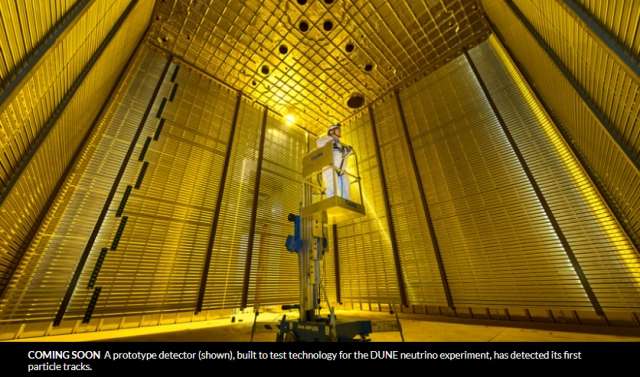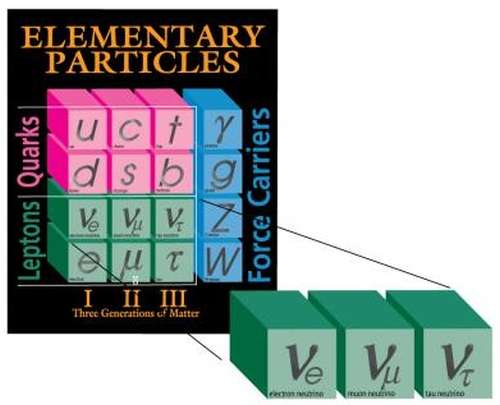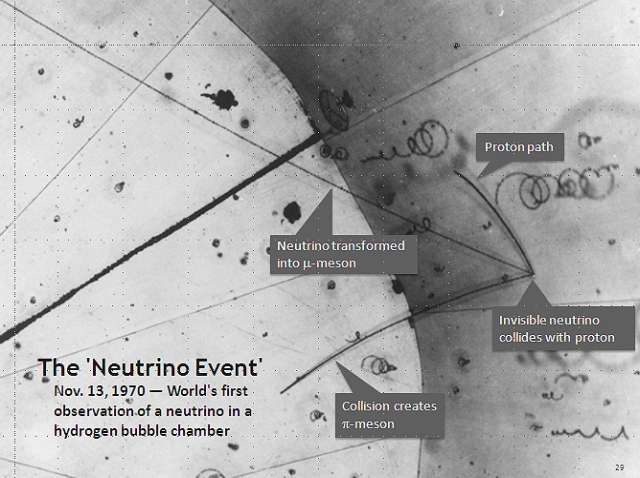
"An enormous future particle detector is now within closer reach. The first data from a prototype experiment hint that scientists may have what it takes to build the planned neutrino detector.
Known as the Deep Underground Neutrino Experiment, or DUNE, the experiment will use 70,000 metric tons of liquefied argon to study the secrets of these neutrinos — bizarre, nearly massless particles that may help reveal why matter is common in the universe but antimatter is rare. DUNE will eventually detect the tracks of charged particles, including electrons and their heavier cousins, muons, that are produced when neutrinos interact.
A smaller prototype built at CERN in Geneva has spotted its first particles, researchers announced September 18. The scaled-down detector traced the paths of muons produced when protons traveling through space slam into Earth’s atmosphere. The prototype is one of two detectors known as ProtoDUNE, which were built to test DUNE’s technology.
Beginning in 2026, DUNE will detect neutrinos beamed from Fermilab in Batavia, Ill. to the detector’s location more than a kilometer underground at the Sanford Underground Research Facility in South Dakota."
In the Standard Model of Particle Physics the most obvious categories are the by now quite well known quarks (up, down, charm, strange, top, and bottom), and another still rather exotic sounding group, the six leptons (electron, electron neutrino, muon, muon neutrino, tau, and tau neutrino). Quarks and leptons are called fermions, and each one of them has a corresponding antiparticle.

Of the three generations of quarks, the first generation is the most stable, and contains also the lightest particles: the up and down quarks. Quarks are never on their own but 'operate' always in 'combinations' which are called hadrons. The best well known hadrons are household names: protons and neutrons. In a proton, two up quarks combine with one down quark. A neutron by contrast consists of one up quark and two down quarks.
Now, quarks have various intrinsic properties, namely electric charge, mass, "color" charge, and "spin". Quarks are the sole elementary particles susceptible to the four fundamental interactions: electromagnetism, gravity, and the strong and weak interactions.
Electromagnetism is the fundamental force best understood and describes the interactions between electrically charged particles like, say, protons and electrons in an atom. If they are equal in number in the atom, their positive and negative charges cancel each other out, thus making the atom electrically neutral. By contrast, if an atom misses one or more electrons, it becomes "positive" and is called an ion.
The strong interaction aka nuclear strong force aka color force is, on a much more fundamental level though, far stronger than the electromagnetic force - at a range of 10 to the minus 15 m (1 femtometer), a whopping 137 times. The strong interaction is observable on two levels or scales: on the "largest" scale, 1 to 3 femtometer, it keeps protons together in spite of their positive charges (no contest, really). On the smallest scale, below 0.8 femtometer, it keeps the up quarks, which are themselves electrically charged, together (in their hadrons, remember).
The weak interaction is the interaction between subatomic particles that causes radioactive decay. For instance, weak interaction causes a neutron to transform - decay - into a proton, an electron, and an electron antineutrino.
Then there is gravity, the most observable fundamental force since it keeps your feet on the ground and the Earth orbit around the sun, but in fact it is the weakest of the four fundamentals: approximately 10 to the 38 times weaker than the strong force, 10 to the 36 times weaker than the electromagnetic force, and 10 to the 29 times weaker than the weak force. It plays therefore no role on the scale of subatomic particles except perhaps for quarks, but even there it's unimportant.
In the lepton group, the electron, the muon and the tau particle do not carry "color" charge hence are not influenced by the strong interaction aka "color force". But they do have an electric charge which means that they are susceptible to electromagnetic forces. And also to the weak interaction.
The three other neutrinos, the subject of this post, are not electrically charged. Since, as we have seen, gravity does not play a role on this level, the neutrinos are subject only to the weak interaction.
These elusive particles were first detected on 13 NOV 1970 at the University of Chicago's Argonne National Laboratory:

In a hydrogen bubble bath", it was observed how a neutrino hit a proton in a hydrogen atom. The collision took place at the point where the three tracks emanate.
That was almost fifty years ago. DUNE, for Deep Underground Neutrino Experiment, is expected to become operational from 2026 on:

Fascinating!
MFBB.